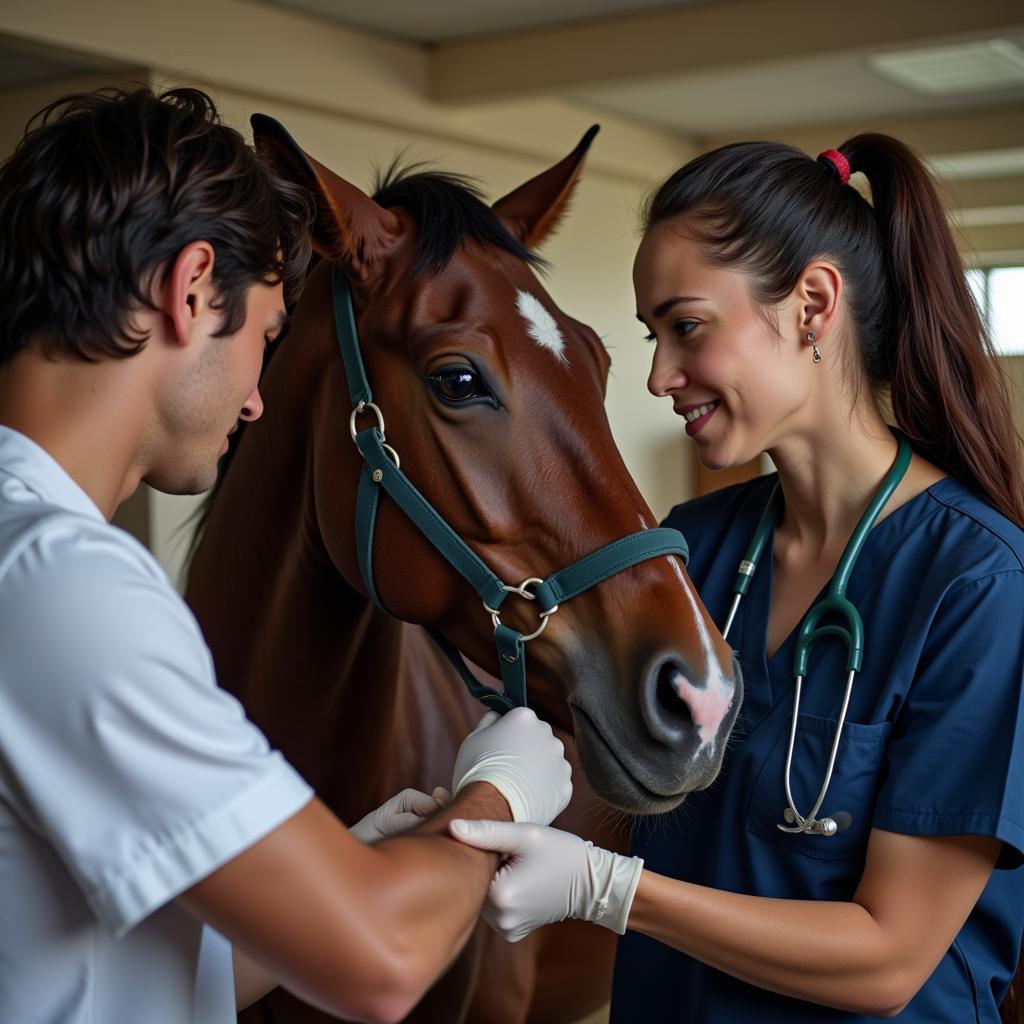Ralgro For Horses is a synthetic hormone implant used to promote growth and improve feed efficiency in beef cattle. While it’s not explicitly approved for use in horses, it’s crucial to understand its potential effects and implications should your horse be accidentally exposed. This article will delve into what Ralgro is, how it works, its potential impacts on horses, and important considerations for horse owners.
Understanding Ralgro and Its Mechanism of Action
Ralgro is the brand name for zeranol, a non-steroidal synthetic growth promoter. It mimics the effects of naturally occurring hormones, specifically estrogens, to stimulate growth and improve feed conversion in cattle. The implant, typically placed in the ear, slowly releases zeranol into the animal’s system. This leads to increased protein synthesis and reduced fat deposition, resulting in faster growth and leaner muscle mass in cattle.
The Potential Impact of Ralgro on Horses
While Ralgro is intended for use in cattle, horses can be inadvertently exposed. Accidental ingestion of discarded implants or contamination of feed or pasture can occur. Although research specifically on the effects of Ralgro in horses is limited, the potential impact can be extrapolated from its known effects in other species and the general understanding of hormone action. The primary concern with Ralgro exposure in horses is its estrogenic activity.
Estrogenic Effects and Potential Risks
Estrogens play a vital role in reproductive function. However, excessive or inappropriate exposure can disrupt normal hormonal balance and lead to a variety of health issues. In horses, potential concerns associated with Ralgro exposure include:
- Reproductive Issues: Estrogenic compounds can interfere with normal reproductive cycles in mares. This can manifest as irregular estrous cycles, difficulty conceiving, and early embryonic loss.
- Behavioral Changes: Hormonal imbalances can also influence behavior. Some horses may exhibit increased aggression, irritability, or other behavioral changes.
- Developmental Issues: Exposure to Ralgro during critical growth periods, particularly in foals, may have long-term consequences on development and overall health.
What to Do if Your Horse is Exposed to Ralgro
If you suspect your horse has been exposed to Ralgro, immediate action is essential. Contact your veterinarian immediately. They can assess the situation, conduct any necessary tests, and provide appropriate treatment and management recommendations.
Diagnosis and Management of Ralgro Exposure
Diagnosing Ralgro exposure in horses can be challenging. There are no specific tests readily available to detect zeranol in horses. Diagnosis often relies on circumstantial evidence, such as the presence of discarded implants in the horse’s environment, combined with clinical signs consistent with estrogenic exposure. Management of Ralgro exposure focuses on supportive care and mitigating potential complications. Your veterinarian may recommend monitoring hormone levels, addressing any reproductive or behavioral issues, and providing nutritional support.
Preventing Ralgro Exposure in Horses
The best approach to managing Ralgro’s potential impact on horses is prevention. Proper handling and disposal of Ralgro implants are crucial to minimizing the risk of accidental exposure.
Best Practices for Handling and Disposal
- Secure Storage: Store Ralgro implants in a secure location, out of reach of animals and children.
- Proper Disposal: Dispose of used implants and packaging materials according to label instructions and local regulations. Never discard them in areas accessible to horses.
- Pasture Management: Regularly inspect pastures for discarded implants and other potential hazards.
- Feed Management: Source feed from reputable suppliers and ensure proper storage to prevent contamination.
Is Ralgro Ever Used in Horses?
While Ralgro is not approved for use in horses, some horse owners might inquire about its potential benefits for growth promotion. It’s crucial to understand that using Ralgro in horses is off-label and carries significant risks. The potential benefits do not outweigh the potential health consequences. Always consult with your veterinarian before considering any off-label medication or treatment for your horse.
Conclusion
Ralgro, while beneficial for growth promotion in cattle, poses potential risks to horses. Understanding the potential effects of Ralgro and taking proactive measures to prevent exposure are essential for responsible horse ownership. By implementing proper handling, disposal, and management practices, horse owners can help safeguard their animals’ health and well-being. If you have any concerns about Ralgro or your horse’s health, contact your veterinarian for expert advice and guidance.
 Veterinarian Examining a Horse
Veterinarian Examining a Horse
FAQs
-
What is Ralgro? Ralgro is a brand name for zeranol, a synthetic growth promoter used in beef cattle.
-
Is Ralgro safe for horses? No, Ralgro is not approved for use in horses and can pose health risks.
-
What should I do if my horse ingests Ralgro? Contact your veterinarian immediately.
-
How can I prevent Ralgro exposure in my horses? Proper storage, disposal, pasture management, and feed management are crucial.
-
Are there any alternatives to Ralgro for horses? Consult your veterinarian for safe and appropriate growth promotion strategies for horses.
Need assistance? Contact us 24/7:
Phone: 0772127271
Email: [email protected]
Address: QGM2+WX2, Vị Trung, Vị Thuỷ, Hậu Giang, Việt Nam.